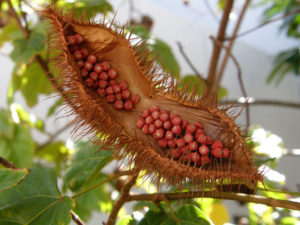If you've ever asked yourself, "why are some cheeses orange?" then you're in the right place. Let's start out by stating that the subject of orange cheese is surrounded by a bit of controversy. It seems like many people think that it's unnecessary, and despite claims that dyeing cheese doesn't affect the taste, many people believe that it does. Additionally, the way that some commercial cheese makers dye cheese with chemicals like yellow 5 and yellow 3. Regardless of whether you agree that cheese should be orange, or not, there is plenty of orange cheese out there in the market.
Most prevalent here in the United States, Cheddar and American is usually what comes to mind. And, it's likely because of marketing efforts from big companies like Kraft that push orange cheese—also, everyone's favorite orange mac n' cheese. However, many artisan cheeses, as you can see in the photo below, are dyed with annatto to achieve anywhere from a light yellow to dark red color.

Red Leicester, Shropshire Blue, Mimolette by Jon Sullivan
What is annatto?
Annatto is an orange-red dye obtained from the pulp of the seeds of the achiote tree. Also, known as the bixa orellana or lipstick tree, this plant is found in tropical climates. The seeds of the plant, are housed in heart shaped seed pods, and have a characteristically brick red color. Not everyone agrees on its classification, but annatto seeds are somewhere between fruits and nuts.

Bixa by Malcolm Manners
So, why do we dye cheese?
It seems to have started because of the seasonality of cheese. You see, dairy cows have little going on beyond grazing and producing milk. And, believe it or not, milk taste and color are highly determined by diet.
In the spring and summer months, cows are able to eat fresh grass. All photosynthetic plants contain a pigment called beta-carotene, which has a strong red-orange color. Of course, some plants—for instance carrots—have a lot more beta-carotene than others; but, even in small amounts the milk color can be visibly affected. So, the milk is essentially dyed by the beta-carotene found in fresh grass—giving it a yellowish color.
What happens in the autumn and winter months, where there isn't a wide availability of fresh grass, cows will eat hay which doesn't have a beta-carotene; and, therefore, the cows will yield white-colored milk.
So, although, there is no real consensus as to why they started dyeing milk with annatto, it's likely that it has to do with one of the following reasons:
- Trick people into thinking that the cheese is fresher than it really is.
- Striving for consistent coloring throughout the year
- Personal preference developed
- Certain advantages of feeding cows hay over fresh grass.
- Yellow cheese is perceived as an indication of quality
- Aesthetics—and visual impact/attractiveness
An aside about annatto's health benefits
I'm not in the business of giving health advice; and, you should certainly talk to you doctor or other licensed professionals before adding pursuing natural remedies for serious illnesses. That being said, annatto has been used to make healing remedies in South America for centuries. According to WebMD, people usually take annatto as a vitamin supplement for diabetes, diarrhea, fevers, fluid retention, heartburn, malaria, and hepatitis. General consensus is that annatto is a food with high amounts of antioxidants, and it has diuretic effects. However, it's not likely that the amount of annatto found in cheese would, say, lower your cholesterol. For more information on the health benefits of annatto you can read more here.
What's your favorite orange cheese? Let me know in the comments below.